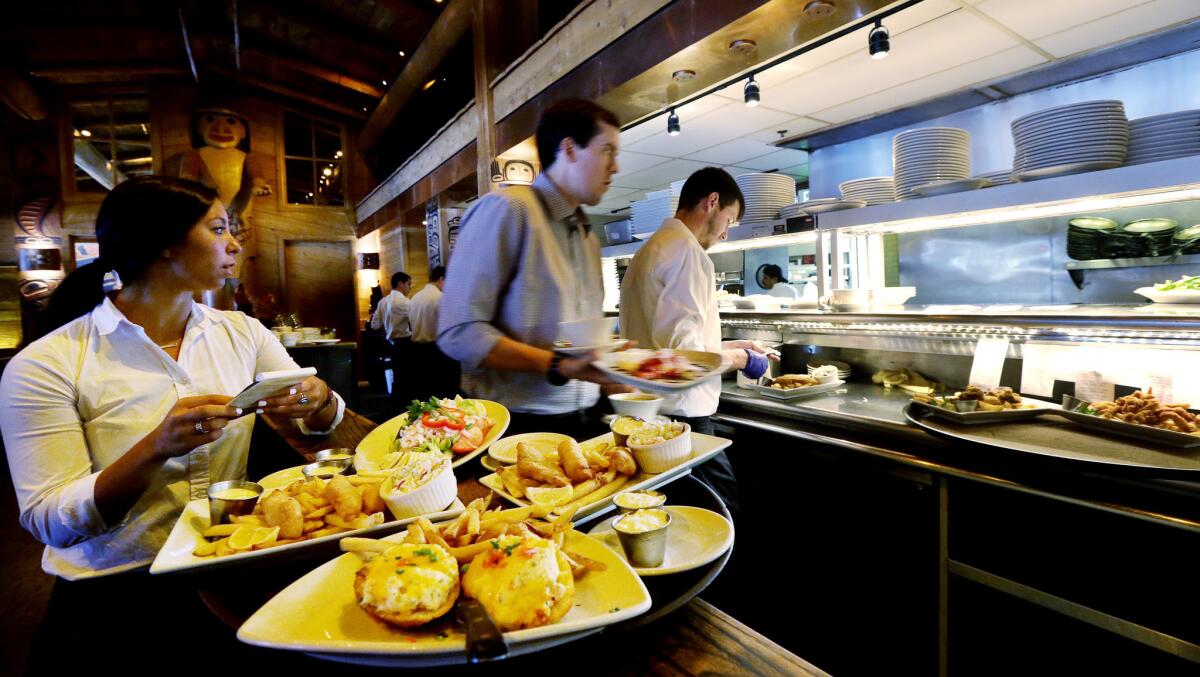Minimum wage fight may heat up after new study finds jobs and hours fell in Seattle
- Share via
It’s one of the core questions in the debate over minimum wage: Does pushing the pay floor to $15 lead businesses to cut hours and jobs?
A much-anticipated study released Monday by a team of researchers at the University of Washington is likely to intensify that controversy — just as Los Angeles heads toward its own minimum-wage increase for large businesses, from $10.50 an hour to $12 an hour on July 1.
The new study has found that jobs and work hours fell for Seattle’s lowest paid employees after the city raised the minimum wage to $13 last year on its march to $15 for all workers by 2021.
The analysis shows that jobs and hours for those workers declined faster in Seattle than in surrounding control areas, where the minimum wage did not increase.
That finding diverges from past studies of minimum wage increases in Seattle and elsewhere, which have found relatively little effect on employment. And some economists see it as a possible sign that $15 minimum wage laws such as those passed in Seattle, New York and several California cities could hurt workers at the lowest end of the wage spectrum.
Seattle has been a leader among the nation’s cities in dramatically raising its wage floor, to one of the highest in the country. For that reason, it has drawn the attention and intense scrutiny of academics and pundits on both sides of the minimum wage debate.
The University of Washington’s ongoing study, commissioned by the city of Seattle, is well suited to measure the results of that experiment because it looks specifically at what happened to workers who earned low wages, independent economists said.
Washington is one of only four states that actually track how many hours each employee works, allowing researchers to identify exactly which workers are paid the lowest hourly wage and how their pay and employment opportunities changed.
Studies of wage hikes in other states and cities have instead focused on broad industries, like restaurants, that tend to pay low wages, or on teenagers, who tend to earn small paychecks.
“This is a study that has the power to move people’s beliefs. It will have a substantial impact on the debate,” said David Autor of MIT, one of the country’s leading labor economists, who reviewed the paper before it was published.
“It suggests we should be proceeding cautiously when we start pushing minimum wages into ranges where they are pretty significant,” Autor said.
Of course, what happens in Seattle could stay in Seattle. The city is unique in that it started from a high wage floor. In two dozen U.S. states, the minimum wage is less than $9 today, and there’s no indication that bringing those rates up incrementally would do any harm.
Under the Seattle wage law, companies with more than 500 workers worldwide that didn’t contribute to worker health insurance saw the minimum hourly rate they were required to pay rise from $9.47 in 2014 to $11 in April 2015. That uptick barely changed the number of low-wage jobs in the city, according to an analysis released last year by the same group of Washington researchers. It was only when the rate went to $13 an hour in January 2016 that the economists started seeing signs of trouble.
Low-wage workers in Seattle — people earning less than $19 an hour — saw their hours decrease by about 9% from 2014 to 2016, compared with the surrounding control area, the study found. The number of low-wage jobs overall declined by nearly 7% relative to the control group.
Emmanuel Saez, an economist at UC Berkeley who also reviewed the paper, agreed that the study was well designed. But he was less sure of its negative implications.
Saez said that it’s possible that a booming Seattle job market drove away low-wage jobs. Seattle’s unemployment rate has dropped to record lows in recent months, reaching 3.2% in May, and employers may have been forced to pass out raises even without a higher minimum, he said.
“I am not yet convinced by this study that the Seattle minimum wage has created large employment losses,” Saez wrote in an email.
Seattle’s 2014 law applied different minimum wage rates depending on the size of the business and whether employees got medical benefits or tips. Franchisees — say, individual McDonald’s restaurants — were counted as large businesses and subject to higher rates.
“The cost of labor is going up and employers are trying to adjust to that by cutting hours worked,” said Katya Jardim, a co-author of the University of Washington report. “It suggests there are at least some workers being impacted negatively by higher minimum wages.”
It is impossible to know for sure how a similar jump will play out in Los Angeles, which has a different economy than Seattle. But some economists said there’s reason to worry.
“Los Angeles should be alarmed by this,” said Edward Leamer, an economist at UCLA. Seattle is packed to the gills with high earners, he said, and is the type of city that economists expect to weather minimum wage increases better than most.
In Seattle, the average hourly wage is about $36, compared with $28 in Los Angeles, according to the Bureau of Labor Statistics.
“A high minimum wage in Los Angeles is likely to do more harm because you have more minority, low-pay, low-skill workers,” said David Neumark, an economist at UC Irvine.
In Los Angeles’ favor is that it is surrounded by urban centers that are also pushing quickly toward a $15 wage floor, giving fewer options to companies looking to move to greener pastures. In Washington, Seattle is the only major city that’s quickly approaching $15.
By 2016, Seattle restaurants had cut hours and jobs for low paid workers, but had hired more highly paid employees, the study found.

The researchers conducted two surveys of 500 businesses, which seem to suggest that restaurants are moving toward a model of either limited service — where people pick up their food at a counter and bus their own tables — or lavish, full-service joints — places where a salad can cost, say, $25.
“It’s an evolution in the types of restaurants you see in Seattle and it’s an evolution in terms of restaurants hiring experienced workers,” said Jacob Vigdor, who co-authored the report.
All restaurants appear to be relying more and more on higher paid workers. That could be happening because Seattle is booming and hordes of new tech workers need fancy places to eat.
“This is happening in Seattle anyway, regardless of the minimum wage; we are seeing a shift away from low-wage jobs and to high-wage jobs,” said Ben Zipperer, of the Economic Policy Institute, a liberal research group.
It could also show that the minimum wage is achieving one of its intended goals, by leading cities away from being centers of low-paying gigs in favor of more lucrative job opportunities.
Either way, that shift could produce losers: teenagers, for instance, and other people who don’t have the skills to vie for positions that pay top dollar.
“If you are someone trying to break into the labor market, get your first job, a young person or immigrant, that’s where it really seems like it’s become more difficult,” Vigdor said.
Researchers at UC Berkeley published a separate report on food services businesses in Seattle earlier this month, which found that pay went up in the sector and the number of jobs didn’t change, compared with a control group that included areas outside of Washington.
The researchers did not have the hourly data that the Washington researchers used, so they could not disentangle low-paid servers and cooks from higher paid ones, or look specifically at work hours.
“You have to have the special micro-data, which only they have. It’s not publicly available,” said Michael Reich, an economist at UC Berkeley and the lead author of that report.
Reich said he was skeptical of the University of Washington research because it found that employers were considerably more sensitive to small changes in the average wage than in any previous study.
“Their results look way off the charts,” Reich said.
He faulted the researchers for using a control group that only included regions within Washington, when bigger cities outside the state have job markets that act more like Seattle’s. He also took issue with the approach because it focused almost exclusively on employers that have one location in Seattle, which excludes retail and restaurant chains.
The report could have overstated the impact on employment, Reich said, because some people who lost jobs at single-site employers may have actually decided to go work at a multisite employer. The report would have labeled that move a job loss.
The Washington researchers said they couldn’t track multisite employers because those businesses don’t identify the specific locations where their employees report to work. However, in separate surveys, where the researchers talked to both types of business, the ones with multiple locations were actually more likely than single-site employers to say they had cut jobs and hours when the wage went up. That suggests that there may have been an even greater job loss for low-paid workers in those bigger businesses.
It is possible that employers didn’t cut as many jobs as it appeared in the study, because some bosses could have responded to a higher minimum by moving low-wage workers into independent contract positions rather than firing them. The researchers didn’t have data on independent contractors, and so they didn’t capture that dynamic.
Follow me @NatalieKitro on Twitter
ALSO
The Internet is mauling America’s malls. Is your favorite retailer closing its doors?
Women in their own words: Why we’re not working
To fight unemployment, Trump plans to push apprenticeships. But will he spend more money on them?
More to Read
Inside the business of entertainment
The Wide Shot brings you news, analysis and insights on everything from streaming wars to production — and what it all means for the future.
You may occasionally receive promotional content from the Los Angeles Times.











